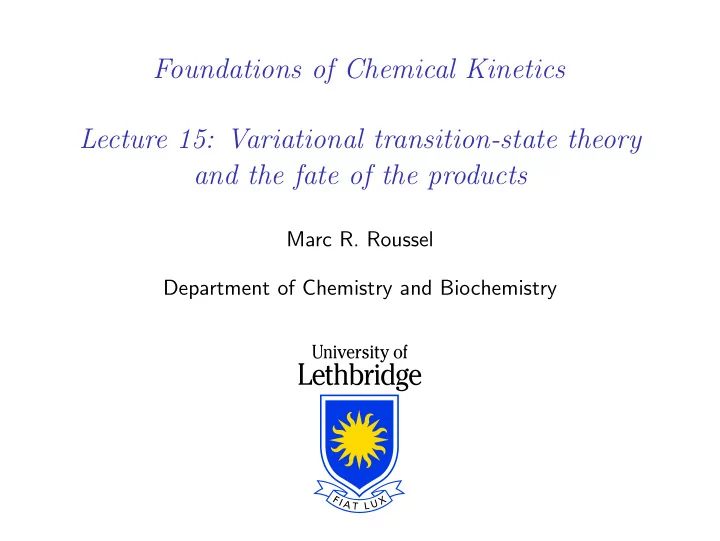

Foundations of Chemical Kinetics Lecture 15: Variational transition-state theory and the fate of the products Marc R. Roussel Department of Chemistry and Biochemistry
Transition-state dividing surface (TSDS)
Recrossing trajectories R BC R AB
The transmission coefficient Suppose that, in the vicinity of the transition state, typical trajectories that cross the TSDS at least once in the reactant to product direction have the following qualitative appearance and frequencies [Truhlar and Garrett, Acc. Chem. Res. 13 , 440 (1980)]: TSDS 40% 20% ◮ Standard TST counts all the reactant-to-product (circled) 20% crossings. ◮ Only the crossings circled in green 10% should count. 10%
The transmission coefficient (continued) TSDS 40% 20% 20% Transmission coefficient = 0 . 4+ 1 2(0 . 1) 10% = 0 . 45 10%
Variational transition-state theory ◮ There is nothing sacrosanct about the TSDS through and perpendicular to the saddle point. ◮ We could equally well pick other dividing surfaces. Basic idea of variational transition-state theory: Vary the TSDS in order to minimize the computed rate constant. Calculation machinery: Very similar to normal transition-state theory, except that we evaluate the partition function at points other than the saddle point.
Variational transition-state theory A possible result Saddle Variational TSDS TSDS 75% 5% 20%
Where does the energy accumulated to get to the transition state go? ◮ Since the transition state is higher in energy than either the reactants or products, the products are not typically in thermal equilibrium when first formed, i.e. they carry excess energy. ◮ Where does this energy go? ◮ Possibilities: Electronic energy: Only in reactions where the products have low-lying excited states, especially if there is an avoided crossing Translational kinetic energy Rotational kinetic energy Vibrational energy: This possibility can be predicted from the shape of the PES.
How vibrationally excited products can arise R BC R AB
How vibrationally excited products can arise Another view V x
Recommend
More recommend